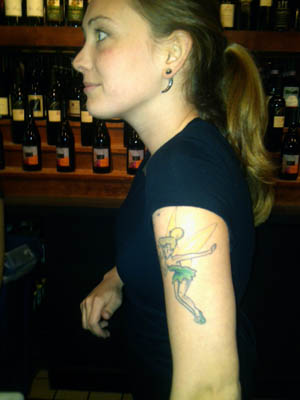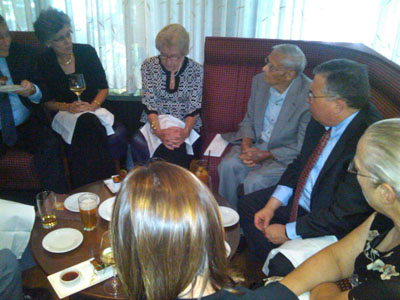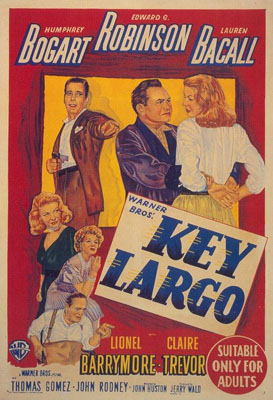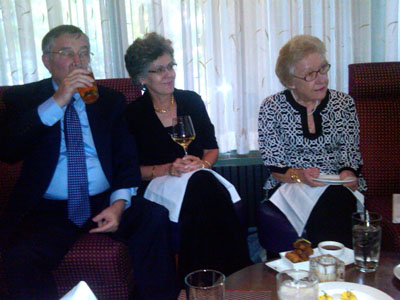
Best ink ever. Photo Socotra.
Tinkerbell was taking care of us well last night. Mac did a second installment on his 92nd birthday, venturing out form The Madison in his golden Jaguar to join some admirers at Willow.
Tink managed to doctor up a Bloody Shame (tomato juice sans vodka) for Mac with almost all the trimmings- cocktail onions, jumbo olives and hot sauce just like Big Jim used to do.
It was the first night without his looming presence behind the bar, but our buddy comma Holly and Tink were all over it- or us, as the case may be.
Aside from Admiral Tom and Clare, the Doc and Deb, and Jake and Celia, it was a little slow, for a Monday. I attributed to the lingering crisis malaise here in the Capital. I leaned over to Doc’s wife Deb to float an idea: “I think that between the debt ceiling, the earthquake and the hurricane, we have been in fight-or-flight mode for months now. The two physical dislocations of the last week have left us all disoriented and fatigued. It is a real physical manifestation of stress.”
She nodded vigorously. “That is exactly what I have been wondering,” she said. “Why I feel so strange. It is very odd, and maybe there is something we share with the animals. The radio was talked about how things were at the National Zoo before the quake, and how they responded to the drop in the barometer when the storm was approaching.”
“Cats don’t get it. Dogs do.”
The good Doctor smiled. “There is no question we managed to avoid multiple disasters this past week, though of course it may be that the hoopla was overstated.”
“Well,” I said, “the earthquake shook up Culpeper pretty well, and damaged the Washington Monument and the National Cathedral, but both will survive in good shape. The hurricane could have been much worse everywhere it passed, and in the end it turned out to be an inconvenience more than peril.”
“Maybe,” he said gravely. “The flooding in Vermont should be noted would concern, but that was a function of rain more than devastating scouring wind. Clearly everyone in politics and the media had a stake in overstating the drama. Plus, they had added staff and with everyone on the payroll, they had to do something with them.”

Admiral Mac holds court. Photo Socotra.
The conversation rolled off in other directions as Mac held court for his bevvy of admirers, and we ordered three separate signature flat-breads, the Pollyface Farms deviled eggs, two orders of the Spring Rolls, and the miniature fish and chips off the neighborhood bar menu.
“It is sort of like a port visit in Barcelona,” said Jake, slurring the ‘c’ sound into a ‘th’ like the residents of that marvelous city do. Tapas galore.”
We got Mac back to his Jag after we finished devouring the food, and I got back to Big Pink in time to tell Adam to hang on, I would be down for a dip before it was closing time. I mixed him a drink to help pass the last few minutes while I paddled, and he seemed to appreciate it.
When the evening was finally verging on completion, I checked the email that had piled up since I left the office.

My pal Muhammed wrote to ask what the hurricane was like. He had watched the wonderful old Bogie-and-Bacall film “Key Largo,” which featured a night in a killer storm with gangster Edward G. Robinson. It is a great film for a hurricane party, if the roof doesn’t come off or the tidal surge doesn’t take you away.
“Not much,” I wrote back. “This one had gust but no fangs.” He has never been through a hurrcane, and I had to think back on just how placid a place my home state of Michigan is, nestled inside all that fresh water, insulated from harm.
I have talked to people who survived the raking blast of Hurricane Andrew at Homestead Air Force Base in 1992. Andrew was a storm so powerful that it literally erased the base, and knocked it out of commission for two whole years. Huddled together in interior bathrooms, listening to the wind smashing windows and ripping parts of the building off.
Scary. Really scary.
I warmed to the subject, thinking back on the storms of my life. I went back, ticking them off, and thinking about fight-or-flight, and the way you feel when you don’t have a choice about how you will deal with the coming wet smothering blast.
Hurricanes are a good experience if you live. Not so much if you don’t. You are truly committed to the storm if you have not run, like they did in Key Largo, and even running doesn’t always work out.
I did Hurricane Iwa in Honolulu in 1982. It was the most powerful hurricane ever to hit Hawaii, and there was no place to run. It was no Andrew, but likewise there was no way to avoid it. The eye of the storm came over the lanai of the little Navy house on McGrew Loop at Pearl Harbor. Looking at the well-defined eyewall that encircled us, the sun returning briefly was the most eerie lovely thing I have ever seen.
Then, eleven years later, Hurricane Isabel came here to DC and crashed into the flanks of Big Pink and the trees danced (as I did) on the balcony with my battery-powered DiscMan CD player.
Then, of course, Saturday night we spent sleeping with Irene.
None of the three were catastrophes. Inconveniences, mostly, though there were tragedies. The strongest hurricane was the first, though of course it was in the Western Pacific, and technically not a hurricane, but a Typhoon.
I saw the power of the storm at sea, on USS Midway. The tropical cyclone was Super-typhoon Tip, and the year was 1979. It was the largest and most intense tropical cyclone in history, which was when people were talking about the coming ice age, not the other way around.
’79 had been an active storm season in the western Pacific- Tip was the nineteenth tropical storm and twelfth typhoon of the season.
Tip developed out of a disturbance in the monsoon trough near Ponape (now Pohnpei) Island in Micronesia early October, and initially tropical storm Roger to its northwest hindered the development and northwest motion of Tip, which may have contributed to its incubation as a monster.
After it got out of Roger’s shadow, the monster tracked further north and intensified from topical storm to Monsoon. After passing Guam, it rapidly intensified and reached peak winds of 190 mph and a worldwide record low sea-level pressure of 870 millibars.
At its peak strength it was also the largest tropical cyclone on record with a diameter of 1,380 miles, or more than a third of the Continental United States.
After pasting Guam, the storm took an unexpected northwestern arc and almost caught us in Tokyo Bay. It hit Japan on the 19th. We had been pier side in Yokosuka when the turn commenced and they ordered us to sortie to get away, but the storm was so vast that we didn’t quite succeed.
It is the only time I have seen green water – un-aerated, no foam- over the bow of an aircraft carrier.
There was widespread destruction. Rainfall from Tip was so intense that the flood breached a retaining wall at a fuel farm on a USMC training base near Fuji, which ran gasoline down into the tents and exploded on a spark from a heater. The subsequent fire killed 13 Marines and injured 68. Elsewhere in Japan, the typhoon led to widespread flooding and 42 deaths, and offshore shipwrecks left 44 killed or missing.
Among the other casualties was the tower of the Armed Forces Radio and Television System (AFRTS) Far East Network (FEN) radio station, 80,000 watts of US-controlled Rock and Roll, which made Japan much more boring without a US-style Top-40 radio station to listen to when we bombed around in our clapped-out Nissans and Hondas.
On the ship, we experienced some damage in terms of swept-away antennas and such, but we popped out of the southern band of clouds into the bright sunshine, and proceeded at best speed to Subic Bay in the Republic of the Philippines. We had no airplanes- they had all been flown away out of danger from Japan, and consequently all the airwing ground pounders were idle passengers.
We wound up in the Philippines unplanned for the voyage repairs and we got intensely drunk on rich dark San Miguel beer and hung out with the hookers in Olongapo City for a week.
Storm avoidance can be a magical thing. Sometimes you can run, and not have to hide.
Copyright 2011 Vic Socotra
www.vicsocotra.com

